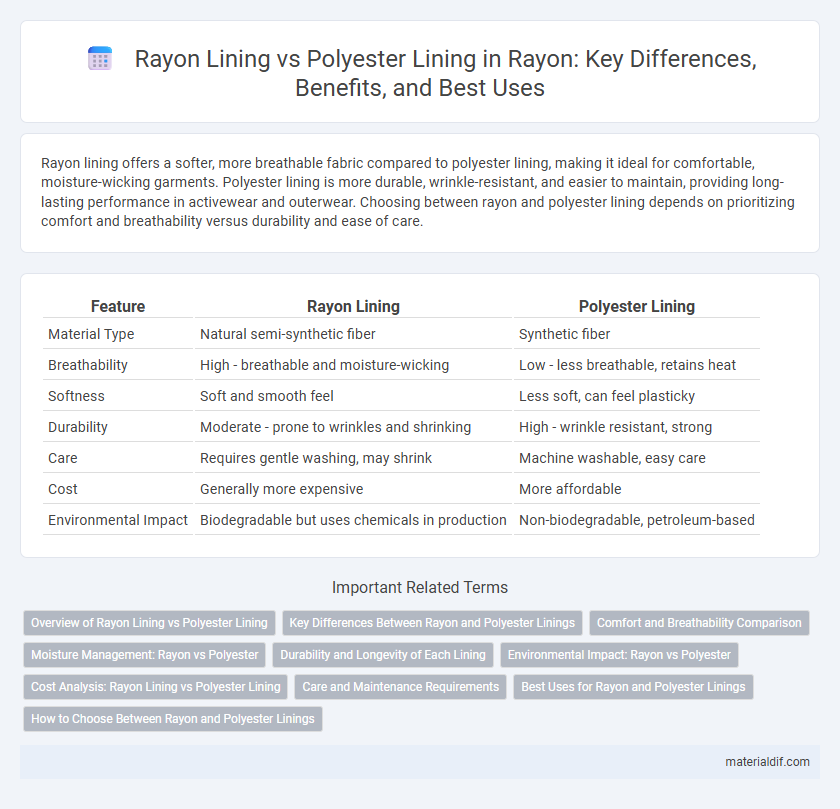Rayon lining offers a softer, more breathable fabric compared to polyester lining, making it ideal for comfortable, moisture-wicking garments. Polyester lining is more durable, wrinkle-resistant, and easier to maintain, providing long-lasting performance in activewear and outerwear. Choosing between rayon and polyester lining depends on prioritizing comfort and breathability versus durability and ease of care.
Table of Comparison
| Feature | Rayon Lining | Polyester Lining |
|---|---|---|
| Material Type | Natural semi-synthetic fiber | Synthetic fiber |
| Breathability | High - breathable and moisture-wicking | Low - less breathable, retains heat |
| Softness | Soft and smooth feel | Less soft, can feel plasticky |
| Durability | Moderate - prone to wrinkles and shrinking | High - wrinkle resistant, strong |
| Care | Requires gentle washing, may shrink | Machine washable, easy care |
| Cost | Generally more expensive | More affordable |
| Environmental Impact | Biodegradable but uses chemicals in production | Non-biodegradable, petroleum-based |
Overview of Rayon Lining vs Polyester Lining
Rayon lining offers a soft, breathable, and moisture-absorbent fabric ideal for comfort in garments, making it a popular choice for high-quality, breathable clothing linings. Polyester lining, known for its durability, wrinkle resistance, and cost-effectiveness, provides a smooth finish with excellent shape retention, commonly used in budget-friendly or performance-focused apparel. The choice between rayon and polyester linings depends on the desired balance of comfort, breathability, and durability in garment construction.
Key Differences Between Rayon and Polyester Linings
Rayon lining offers superior breathability and moisture absorption compared to polyester lining, making it ideal for comfort in warm weather. Polyester lining provides greater durability and resistance to wrinkles and shrinkage, resulting in easier maintenance and longer-lasting garments. The key differences lie in rayon's natural fiber-like feel versus polyester's synthetic strength and resilience.
Comfort and Breathability Comparison
Rayon lining offers superior comfort and breathability due to its natural cellulose fibers that wick moisture and allow air circulation, reducing heat buildup. Polyester lining, made from synthetic fibers, tends to trap heat and moisture, making it less breathable and often causing discomfort during prolonged wear. Choosing rayon lining enhances garment comfort, especially in warm or active conditions, by promoting better airflow and moisture management.
Moisture Management: Rayon vs Polyester
Rayon lining offers superior moisture management compared to polyester lining due to its high absorbency and breathability, which allows sweat to evaporate more efficiently. Polyester lining, while less absorbent, dries faster and resists moisture buildup, making it suitable for activewear needing quick-dry properties. Choosing between rayon and polyester lining depends on the desired balance of moisture absorption and drying speed for optimal comfort.
Durability and Longevity of Each Lining
Rayon lining offers a soft, breathable texture but tends to have lower durability and longevity compared to polyester lining. Polyester lining is highly resistant to wear, moisture, and shrinking, providing enhanced durability and extended lifespan in garments. Choosing polyester lining ensures better performance in maintaining fabric integrity over time, making it ideal for frequent use and heavy-duty applications.
Environmental Impact: Rayon vs Polyester
Rayon lining, derived from cellulose fibers, is biodegradable and has a lower environmental footprint compared to polyester lining, which is a synthetic polymer made from petroleum. Rayon production consumes less energy and generates fewer greenhouse gas emissions than polyester manufacturing, which relies heavily on fossil fuels and contributes to microplastic pollution. However, rayon processing involves chemical treatments that can pose environmental hazards if not managed responsibly, while polyester's durability results in longer-lasting products but slower decomposition.
Cost Analysis: Rayon Lining vs Polyester Lining
Rayon lining typically costs more than polyester lining due to its complex manufacturing process and natural fiber origins, which contribute to higher raw material expenses. Polyester lining offers a more affordable option with its synthetic production and lower labor costs, making it popular in mass-market apparel. When analyzing cost efficiency, polyester provides greater budget flexibility without sacrificing durability, while rayon's premium price may be justified by its superior breathability and luxurious feel in high-end garments.
Care and Maintenance Requirements
Rayon lining requires gentle care, typically hand washing or dry cleaning to prevent shrinkage and maintain fabric integrity, as it is prone to wrinkles and damage from harsh detergents. Polyester lining is more durable and low-maintenance, allowing machine washing and faster drying without losing shape or color. Choosing rayon for lining demands careful handling to preserve softness and appearance, while polyester offers convenience and longevity in garment care.
Best Uses for Rayon and Polyester Linings
Rayon lining excels in breathability and moisture absorption, making it ideal for lightweight, summer garments and linings in formal wear where comfort and softness are prioritized. Polyester lining offers durability, wrinkle resistance, and quick drying properties, suitable for activewear, outerwear, and winter coats requiring long-lasting, easy-care fabrics. Choosing between rayon and polyester linings depends on the desired balance between natural fiber comfort and synthetic fiber performance in specific clothing applications.
How to Choose Between Rayon and Polyester Linings
When choosing between rayon and polyester linings, prioritize breathability and comfort based on the garment's intended use; rayon offers superior moisture absorption and softness, making it ideal for breathable, natural-feeling linings. Polyester provides durability, wrinkle resistance, and cost-effectiveness, suited for outerwear or garments requiring easy maintenance. Assess fabric weight, climate considerations, and care instructions to align lining choice with performance and longevity needs.
Rayon Lining vs Polyester Lining Infographic

 materialdif.com
materialdif.com